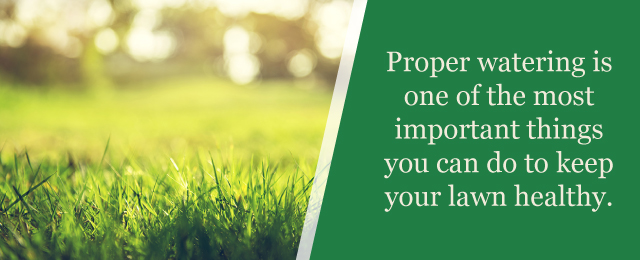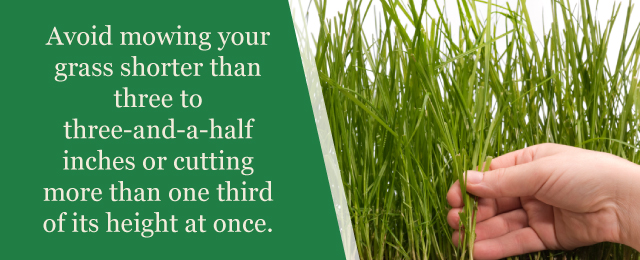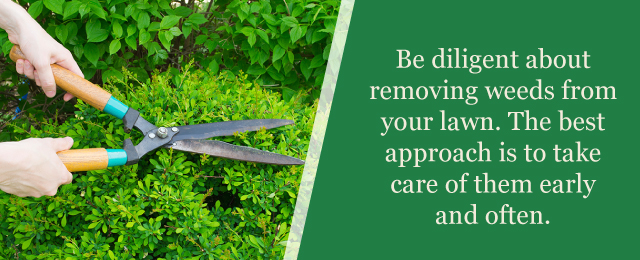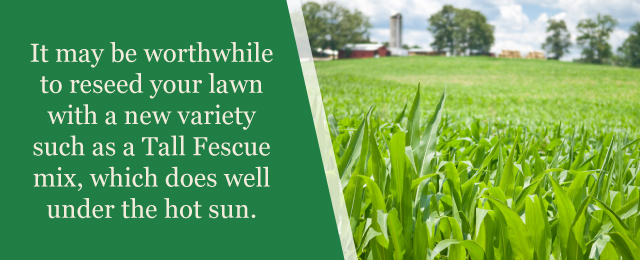Summer is the time when we want our lawns to look their best. But it’s also the time they undergo the most stress. Drought and hot temperatures threaten to fry our carefully cultivated, lush, green lawns. Increased traffic from pets and kids cause more wear and tear than we’d like. Warm weather can cause insect and disease issues to arise. Combined, all of these factors can leave our once-green lawns looking brown and dry.
While hot and dry weather may be inevitable, a brown lawn doesn’t have to be. Of course, some homeowners embrace the brown and allow their grass to go dormant in the summer. While this is a safe option for your lawn’s health, most prefer to keep their lawn green all summer long. The process of keeping grass green in the summer is not complicated. With some strategic watering and mowing practices and the right tools and products, you will be able to maintain your green grass from spring to fall.
If you are in need of grasses, we have an excellent selection of grasses and groundcovers for sale in Bowie, MD If you’re interested in improving your lawn’s color read on for tips on how to keep your grass green in the summer — and hot weather in general.
What Causes Your Lawn’s Color to Fade?
To understand how to keep your lawn green, it helps to first understand what causes grass to lose its green color in the first place.
In some climates, the weather can go from one extreme to another relatively quickly. It might be cool and wet in the spring, then hot and dry mere weeks later. These changes can cause the ground to dry out quickly and leads to lawns starting to turn brown.
Hot and dry weather combined with other factors will cause your lawn to lose its healthy, green appearance. Here are just some of the things that can result in grass losing its color:
- Improper Watering: Watering too lightly or too frequently will prevent the roots from being fully saturated. In addition, if you water too late in the day, you may risk having too much of the water evaporate.
- Improper Mowing: Mowing the grass too short or waiting too long between mowings can be detrimental to the health of your turf. Mowing too short can scorch the lawn and prevent the roots from developing. In general, cutting off more than one-third of the length of the grass can be harmful. Because of this, it’s important not to let your grass get too long.
- Insects or Disease: Problems with insects or disease are more likely to arise in the warmer months. These problems might cause brown spots in your grass that do not go away with regular watering.
- Excess Traffic: Quite often, our lawns are for more than just admiring. Animals make their way into our yards, children play on the lawn, workers may come and go and, occasionally, vehicle traffic may cross our lawns as well. All of these activities put stress on turf, causing it to lose its healthy appearance.

How to Keep Your Lawn Green in the Summer
There are several steps that can be taken to keep your lawn healthy and green even during the hottest, driest days of summer. Keeping your grass green throughout the summer months doesn’t have to be overly complex. By following these tips with consistency, your lawn should remain beautiful all season long.
1. Be More Mindful of Your Watering Habits
Proper watering is one of the most important things you can do to keep your lawn healthy. When done incorrectly, turf will suffer under the hot sun and lose its healthy, verdant look. Here are some practices to follow to ensure your lawn is getting the moisture it needs:
- Soak the Grass During Dry Spells: In summer, the time between rainfalls could last for weeks. During dry periods, the grass will become dormant to conserve energy. It might appear dry and brown or tan in color. This is the plant’s method of defending itself against drought, and it will usually recover in the fall when the weather is cooler and wetter. Regular watering in the summer can prevent dormancy and help train your turf to develop deep roots that will endure the heat of summer. For best results, try to water in a way that mimics the pattern of rainfall. This means soaking the grass at infrequent intervals. Watering grass deeply, but infrequently, will help to saturate the root zone and lead to deeper roots and a healthier plant. Generally, you should soak the grass three to four times per week, applying about one inch of water per week to your lawn. This will produce healthier grass than daily watering.
- Water in the Morning: Watering is most beneficial when done early in the morning. To reduce water evaporation, it’s best to water between 6 and 10 AM. If you water midday when the sun is high in the sky, your lawn will not benefit as much, since some of the water will evaporate before the turf has a chance to absorb it. It’s also important to water when the sun is out, so the grass can go through the process of photosynthesis. If you water at night, the grass will not be able to effectively absorb and make use of the water. In addition, the increased dampness could lead to the development of diseases.
- Pay Attention to Where the Water Goes: To avoid wasting time and money, keep a close eye on your lawn while watering. Try to avoid runoff or watering pavement or pathways. If you notice water starting to run off or form puddles, it might be time to move your sprinkler to another location. If runoff occurs before your lawn has had a chance to soak, turn off the water for about 15 to 20 minutes to allow the water to fully absorb. Then, try again. Many homeowners waste water by accidentally watering driveways, sidewalks or other pathways. Try to direct all of the water toward your grass. Consider investing in an adjustable sprinkler that’s appropriate for the size and shape of your lawn.
- Avoid Watering in the Rain: This might seem like an obvious tip, but watering in the rain is an easy mistake to make if you have an automatic sprinkler system. Instead, remain flexible with your watering schedule. Plan to turn off your watering system when rain is in the forecast and be ready to get back to your watering schedule when the weather is dry again.
- Don’t Use Hot Water: When a hose is left lying in the sun with water still in it, the water can become hot enough to scorch the grass. Be careful to empty your hose after each use to avoid doing damage to your grass with too-hot water.

2. Keep Your Grass Longer
Mow your grass on a higher setting. Longer grass will allow for the establishment of longer roots, which can reach more moisture in the soil — even when the weather is hot and dry. Keeping grass longer will prevent it from drying out too quickly and ensure that roots are better protected by the longer blades.
Mowing the grass too short can cause damage. It can leave the lawn scorched to the point where the grass may not be able to recover. Luckily, this problem is totally avoidable. As a general practice, avoid mowing your grass shorter than three to three-and-a-half inches or cutting more than one-third of its height at once. Mowing more frequently will make it easier to mow to the right length while still adhering to these guidelines.
Keep in mind that if you choose to mow your grass short, you will have to water it more often and more lightly. Light and frequent watering will cause shorter roots. In turn, this increases stress during droughts.
3. Feed Your Lawn
Your lawn needs a source of food to stay healthy. Applying a slow-release fertilizer provides a source of nutrients and helps protect the turf from getting burned.
It takes about six to eight weeks for the microbes in the soil to process nutrients. That means it’s important to fertilize your lawn at regular intervals. Replenishing nutrients on a regular basis will help the grass to grow thick, which helps to crowd out weeds and keep the soil cool.
If your grass is already dormant, hold off on applying fertilizer. It’s best to wait to fertilize until more rainfall has occurred and the grass has had a chance to revive.
It’s important to note that many insects are more active during the warmer months as well. If you notice any brown spots on your lawn that don’t go away after watering, you may have an insect or disease issue.
4. Take Care of Weeds
Be diligent about removing weeds from your lawn. The best approach is to take care of them early and often, rather than applying weed killer to the entire lawn at once. Instead, pull weeds manually or use a weeding fork. To treat a larger area, try applying weed killer by “painting” it onto the entire affected area.

5. Aerate Your Lawn
Your lawn needs to be able to “breathe.” Plus, aerated lawns will be better able to absorb water, which will lessen the occurrence of runoff. A simple and economical way to aerate is to use a garden fork. Push the garden fork into the ground at approximately one-foot intervals. For a larger lawn, rent an aerator to make the job easier.
6. Watch for Wear and Tear
Your lawn can undergo added stress simply from everyday traffic. Children, animals, workers or vehicles can cause significant wear and tear on your grass and the ground underneath. Excess traffic can cause the structure of the plant to become damaged. If you notice damage from traffic on your lawn, be sure to avoid the damaged area until it has the opportunity to recover.
To avoid damage from regular wear and tear, overseed your lawn at the beginning of fall. This will help thicken the lawn for the next season and help repair damage from the current year as well.
7. Try a New Variety of Grass
One way to achieve a healthy lawn is to know what type of turf you have. Most lawns are a mix of Perennial Rye, Kentucky Bluegrass and Fescue. Some turf becomes stressed when exposed to hot temperatures. If it’s healthy grass, it may be able to recover. But if it’s already experiencing stress from drought, mowing damage or insects and disease, it might not bounce back.
If you have an older lawn, it might be time to consider a more thorough renovation. Some older varieties of turf may not be able to handle the heat as well, while newer varieties are better equipped to cope with hot temperatures. It may be worthwhile to reseed your lawn with a new variety such as a Tall Fescue mix, which does well under the hot sun.

Speak to an Expert at Patuxent Nursery
For more answers to your questions about lawn care, visit the experts at our Garden Center in Bowie, MD. There, you will find everything you need to keep your lawn green and healthy — as well as a friendly and knowledgeable staff to help you choose the right tools and supplies for your needs.
Patuxent Nursery, located in Bowie, Maryland, was started in 1996 by longtime area residents Don and Susan Stelfox. Originally geared toward landscape professionals, Patuxent soon expanded to serve homeowners in Bowie and the surrounding areas in Maryland, Washington, D.C. and Northern Virginia.
Our store offers customers a unique shopping experience and features a gardening-oriented gift shop, outdoor living accessories, an assortment of colorful flowers and edibles and the largest selection of trees and shrubs in the metro area.
We specialize in lawn care and we carry all of the products you need to maintain an attractive lawn, including seed, soil amendments, pest and disease control products, weed killer, weed-and-feed, fertilizers and soil conditioners.
Contact Grass experts in Bowie, MD to speak to an expert at our store today and find out how to keep your lawn healthy and green all summer long.


If there’s one thing I love in my house: it’s my luscious lawn. I really think it’s the perfect addition to our property so I’m keen on hiring a grass service that’ll help me maintain it. Thanks for talking about how if your property has an automated sprinkler system, watering in the rain is a simple error to make. Instead, you said to keep your watering schedule flexible. Thanks again for this.